Top 43 Places To Visit In Jaipur | Things To Do | Best Time to Visit
Jaipur, often referred to as the “Pink City,” stands as the capital and largest city of the Indian state of Rajasthan. Founded in 1727 by Maharaja Jai Singh II, Jaipur is renowned for its exquisite architecture, vibrant culture, and rich tapestry of history. The city earned its nickname due to the distinctive terracotta-pink hue that adorns many of its historical buildings. Nestled in the arid landscapes of Rajasthan, Jaipur is a captivating blend of tradition and modernity. The city’s historical heart encompasses a maze of colorful markets, grand palaces, and imposing forts, each narrating tales of Rajput valor and opulence. Visitors can explore iconic landmarks like the Hawa Mahal, a palace with intricate latticework, and the imposing Amer Fort, perched on a hill with stunning views. Jaipur’s City Palace, a magnificent blend of Rajput, Mughal, and European styles, is a testament to the grandeur of the city’s royal heritage. The Jantar Mantar, an astronomical observatory, showcases the scientific prowess of the past. The city is also known for its bustling bazaars, offering a treasure trove of textiles, jewelry, and handicrafts.
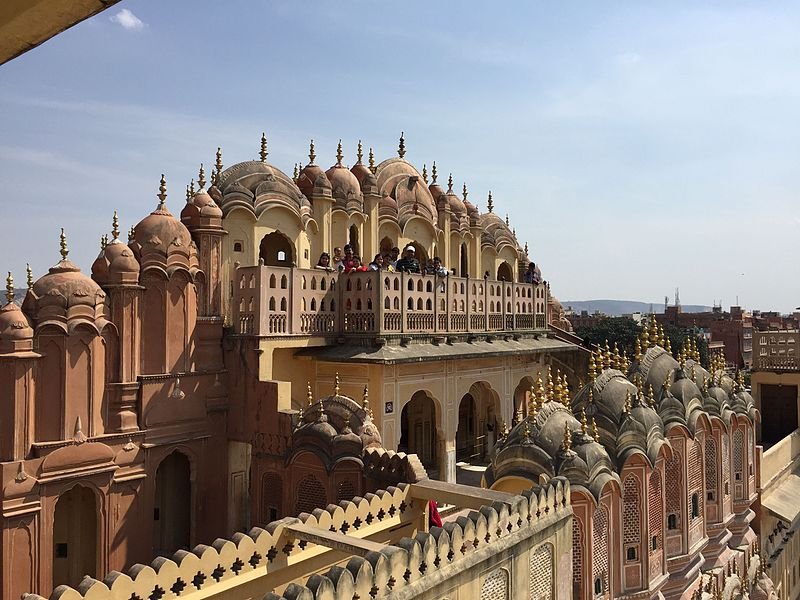
Best Places To Visit In Jaipur
Jaipur enchants visitors with its rich history and architectural splendor. its iconic structures like Amer Fort, Hawa Mahal, and City Palace narrate tales of Rajput grandeur. The city’s unique charm extends to the ancient Jantar Mantar observatory and the serene Jal Mahal in Man Sagar Lake. Jaipur’s lively markets, such as Bapu Bazaar and Johari Bazaar, offer a kaleidoscope of colors and cultural treasures. With a perfect blend of historic forts, vibrant markets, and architectural wonders, Jaipur stands as a testament to India’s cultural richness and regal heritage.
Here are some places to visit to in Jaipur:
1. Amber Palace
Amber Palace, also known as Amber Fort or Amer Fort, is a magnificent fort and palace complex in Jaipur, Rajasthan, India. It was built by Raja Man Singh I in 1592 and later expanded by his successors. The palace is a blend of Rajput and Mughal architectural styles, featuring red sandstone and white marble structures, courtyards, gardens, temples, and halls. Some of the notable attractions of the palace are the Sheesh Mahal (mirror palace), the Diwan-e-Aam (hall of public audience), the Diwan-e-Khas (hall of private audience), and the Sukh Niwas (pleasure palace). The palace overlooks the Maota Lake, which provides a scenic backdrop and a source of water. The palace is also connected to the Jaigarh Fort by a subterranean passage, which was used as an escape route in times of war. Amber Palace is a UNESCO World Heritage Site as part of the Hill Forts of Rajasthan and a popular tourist destination in Jaipur. The Amber Palace, open from 9:00 AM to 5:30 PM daily, charges an entry fee of Rs. 100 for Indian tourists and Rs. 500 for foreign tourists. An evening light show is also offered, with tickets priced at Rs. 200 for English and Rs. 100 for Hindi.
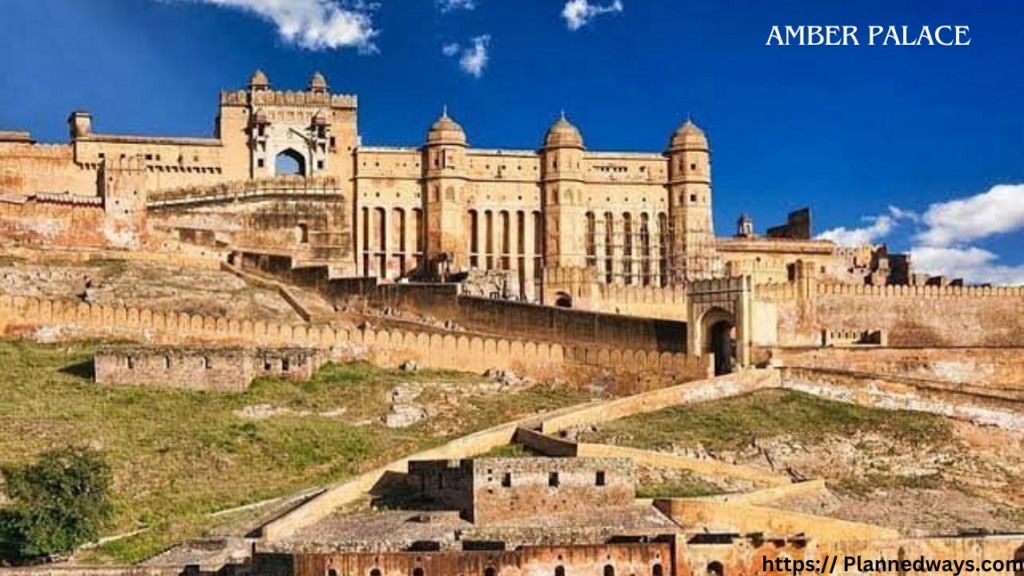
2. Elefantastic
Elefantastic is a unique and immersive elephant sanctuary that offers visitors a chance to connect with these majestic creatures in an ethical and responsible manner. The sanctuary focuses on elephant welfare and conservation, providing a sanctuary for rescued elephants. Visitors can engage in various activities, including feeding, bathing, and painting elephants, all while learning about their behavior, conservation efforts, and the importance of ethical elephant tourism. Elefantastic aims to promote awareness and appreciation for elephants while ensuring their well-being and contributing to conservation efforts. Elefantastic, open daily from 9:00 am to 5:00 pm, offers varied entry fees depending on the season and chosen activities. The day trip package costs INR 3500 per person for Indians and INR 5100 for foreigners in summers, and INR 3000 and INR 4000 respectively in winters. This inclusive package covers lunch or dinner, non-alcoholic drinks, paint, as well as photography and videography fees.
3. Jantar Mantar
Jantar Mantar is an extraordinary observatory constructed by Maharaja Jai Singh II in the early 18th century. Known for its impressive and colossal astronomical instruments, Jantar Mantar is a testament to the scientific advancements of its time. The observatory comprises a collection of large-scale instruments, including sundials, astrolabes, and celestial globes, designed to measure time, predict eclipses, and track the positions of celestial bodies. Visitors to Jantar Mantar can marvel at the precision and ingenuity behind these ancient instruments while gaining insights into the rich astronomical heritage of India.
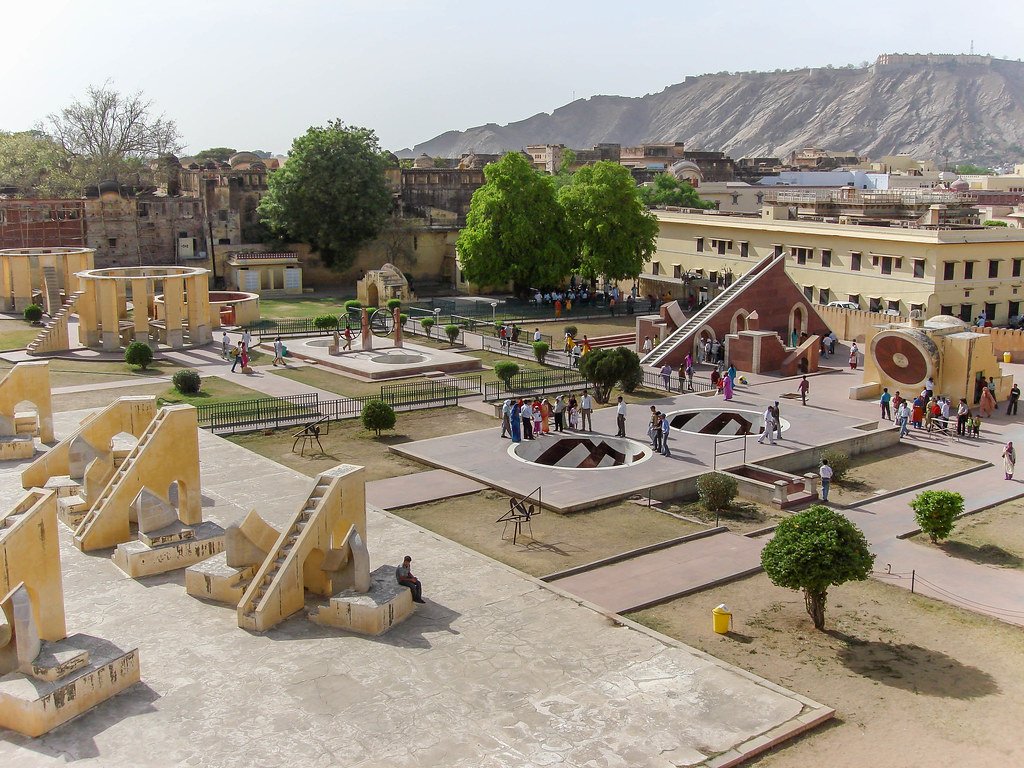
4. Hawa Mahal – Palace of Wind
Hawa Mahal, often referred to as the “Palace of Winds,” is a captivating architectural gem. Built in 1799 by Maharaja Sawai Pratap Singh, this unique structure is renowned for its intricate honeycomb facade featuring 953 small windows, or “jharokhas.” These windows were designed to allow royal women to observe street festivities and daily life without being seen. The five-story palace, constructed of pink and red sandstone, stands as an iconic symbol of Jaipur’s heritage and offers a fascinating glimpse into the royal history of Rajasthan. Visitors are drawn to the Hawa Mahal not only for its historical significance but also for the stunning panoramic views it provides of the bustling streets below. Hawa Mahal is open from 9:00 am to 5:00 pm every day. The entry fee for Indians is INR 50 and for foreigners is INR 200.
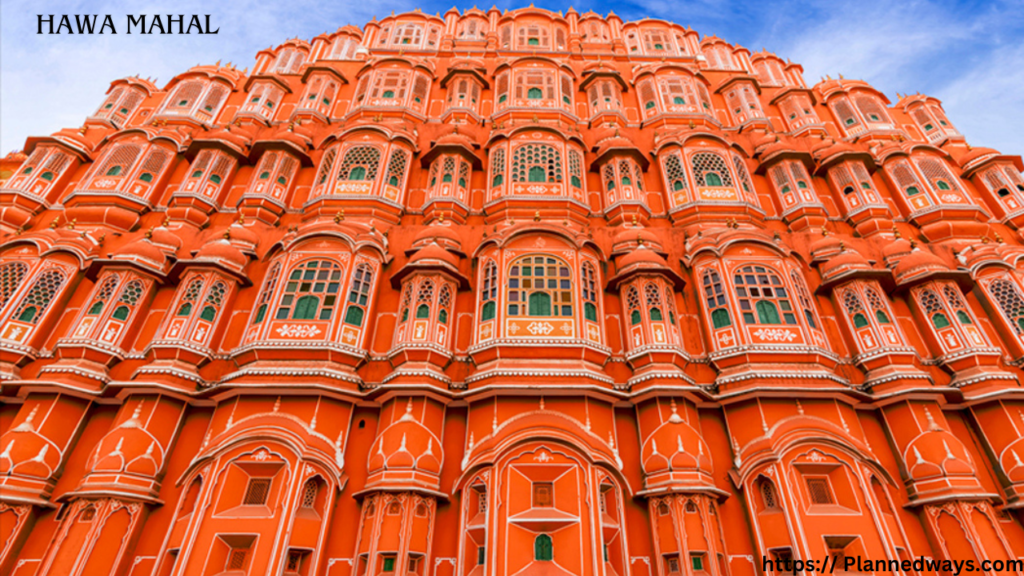
5. Sheesh Mahal (Hall of Mirrors)
Sheesh Mahal, or the Hall of Mirrors, is an enchanting feature within the Amber Fort in Jaipur. This exquisite palace is renowned for its dazzling interior adorned with intricate mirror work. It was built in the 16th century by Maharaja Man Singh and completed by 1727 AD. Sheesh Mahal is a testament to the artistic brilliance of the Rajput era. The walls and ceilings of the palace are adorned with an intricate mosaic of tiny mirrors, creating a glittering effect that is especially mesmerizing when illuminated by candlelight. This stunning play of reflections not only adds to the aesthetic appeal of the palace but also served practical purposes, as it allowed the royal occupants to enjoy a glittering, star-like ambiance within the confines of the palace. Sheesh Mahal stands as a captivating testament to the craftsmanship and opulence of Rajasthan’s historical architecture. The entry fee is INR 10 for Indians and INR 50 for foreign tourists. You also need to pay an additional fee for carrying cameras. The palace is open from 9:30 am to 4:30 pm every day.
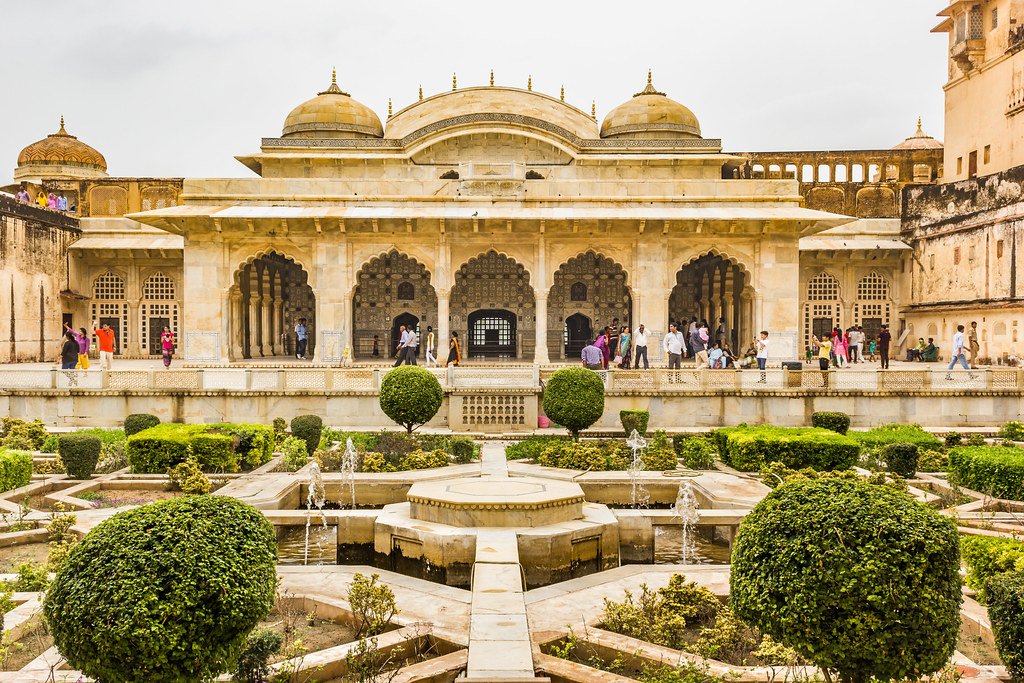
6. City Palace of Jaipur
The City Palace of Jaipur stands as a majestic testament to the grandeur of Rajasthan’s royal heritage. Constructed in the 18th century by Maharaja Sawai Jai Singh II, the palace is a harmonious blend of Rajput, Mughal, and European architectural styles. Located in the heart of the Pink City, the City Palace is a sprawling complex of courtyards, gardens, and palaces. Its impressive architecture showcases a series of intricately decorated structures, including the Chandra Mahal and Mubarak Mahal. The Chandra Mahal is the residence of the current Maharaja of Jaipur and boasts exquisite paintings, mirrors, and ornate decorations. The Mubarak Mahal, once a reception hall, now houses the Maharaja Sawai Man Singh II Museum, displaying an extensive collection of royal costumes, textiles, and artifacts. Visitors to the City Palace can explore the Diwan-e-Aam (Hall of Public Audience) and the Diwan-e-Khas (Hall of Private Audience), each adorned with beautiful paintings, crystal chandeliers, and historical artifacts. The palace complex also offers panoramic views of Jaipur from its elevated position. The City Palace is accessible for day visits from 9:30 am to 5:00 pm and for night visits from 7:00 pm to 10:00 pm every day. The entry fees vary based on nationality and the selected ticket type. Below is a list of ticket prices for different categories:
| Ticket Type | Indian Nationals | Foreign Nationals |
|---|---|---|
| Museum | INR 200 | INR 700 |
| Composite | INR 300 | INR 1000 |
| Museum at Night | INR 500 | INR 1000 |
| Sculpture Lumière Show | INR 250 | INR 500 |
| Royal Splendor | INR 3000 | INR 4000 |
| Royal Grandeur | INR 1500 | INR 2000 |
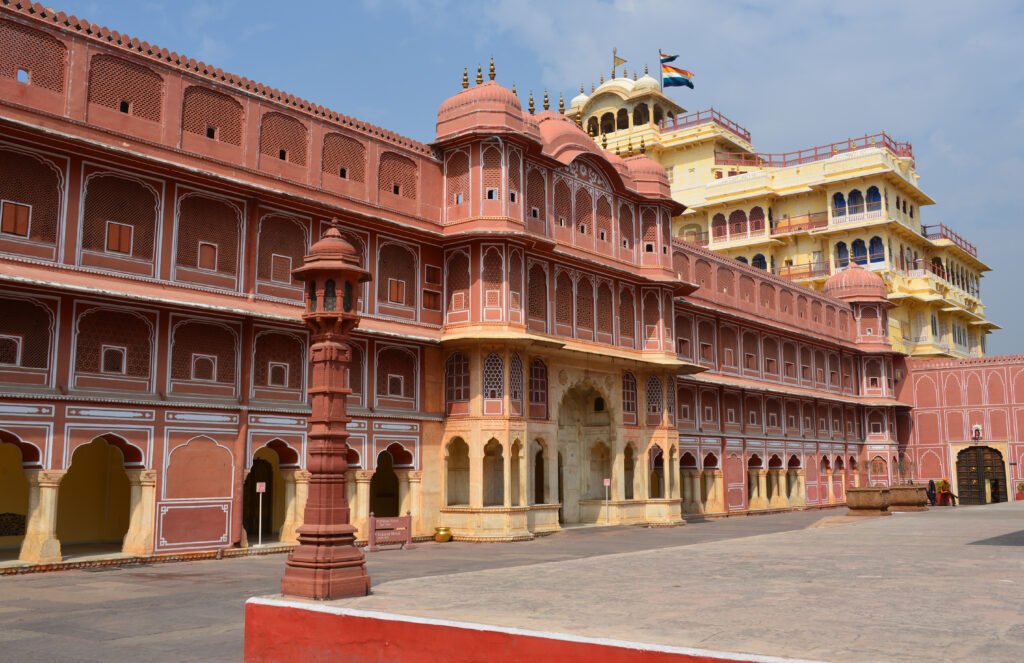
7. Birla Mandir Temple
Birla Mandir Temple, also known as Lakshmi Narayan Temple, is a contemporary Hindu temple located in Jaipur, India. Established by the B.M. Birla Foundation in 1988, the temple is constructed using white marble and adorned with gold. Dedicated to Lord Vishnu and Goddess Lakshmi, it features sculptures and paintings depicting various Hindu deities, as well as figures from other religions and philosophies. With three domes symbolizing the diversity of Indian culture and stained glass windows illustrating scenes from Hindu mythology, the temple serves as a popular tourist destination and stands as a symbol of peace and harmony.
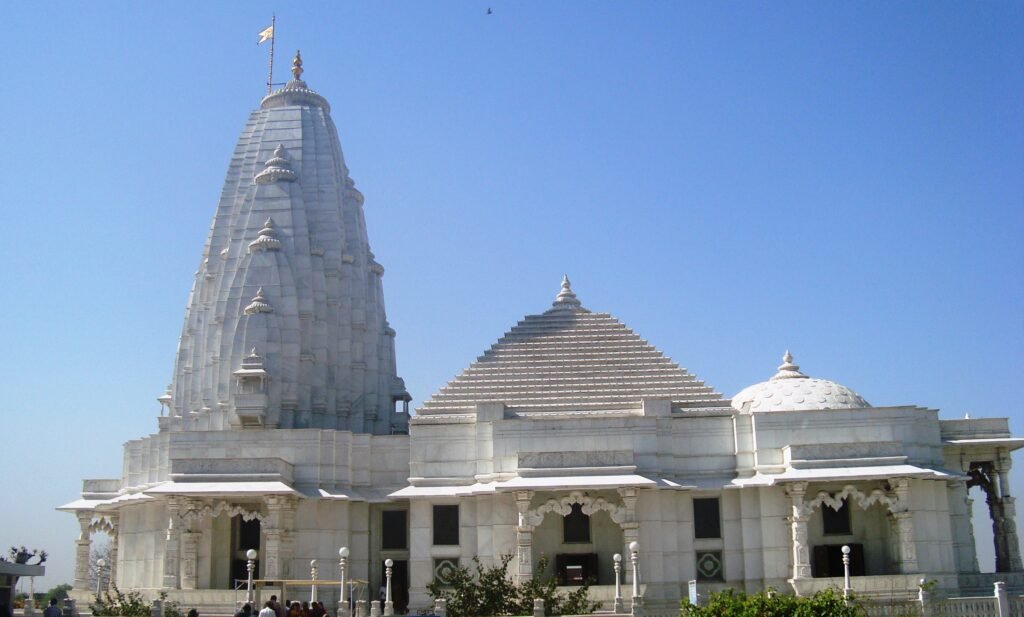
8. EleSafari
EleSafari in Jaipur offers a unique and eco-friendly way to explore the rich cultural heritage and natural beauty of the region. Visitors can embark on a safari adventure aboard specially designed electric rickshaws, allowing them to witness the architectural marvels, historical sites, and vibrant local life of Jaipur while minimizing their environmental impact. EleSafari provides an immersive and sustainable travel experience, blending the charm of traditional transportation with modern ecological considerations for a memorable journey through the Pink City.
EleSafari offers elephant rides from 11:30 AM to 6:30 PM, priced at around Rs. 1,500 per person. Booking is available online through their website or by calling 098707 07676.
9. Jaigarh Fort
Jaigarh Fort, constructed in 1726 by Mirza Raja Jai Singh, stands proudly overlooking the Amer Fort and Maota Lake in Jaipur. Its purpose was to safeguard the Amer Fort and its palace complex. Noteworthy for housing the world’s largest cannon on wheels, Jaivana, the fort features a museum, garden, and water reservoir. It stands as a testament to the military prowess and architectural brilliance of the Rajput rulers. Jaigarh Fort, open from 9:00 AM to 4:30 PM, charges Rs. 35 for Indian visitors and Rs. 85 for foreign tourists. Camera charges are Rs. 50, and video camera charges are Rs. 200.
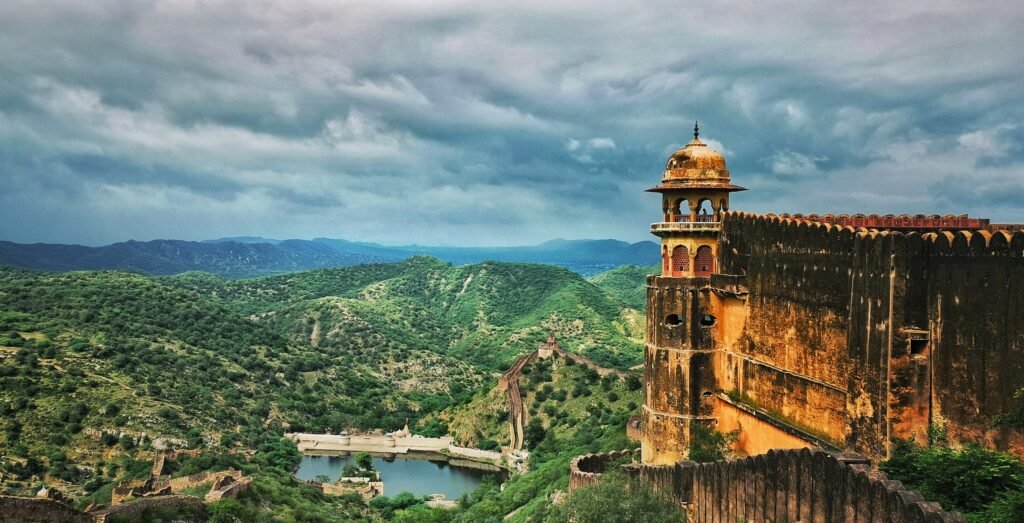
10. Nahargarh Fort
Nahargarh Fort, situated on the Aravalli hills overlooking Jaipur, was built in 1734 by Maharaja Sawai Jai Singh II. Named after Nahar Singh, a Rathore prince, the fort offers panoramic views of the Pink City. It features impressive architecture, palaces, and step wells, making it a popular tourist destination. The fort played a crucial role in defending the city against potential invaders. Today, it stands as a testament to Jaipur’s rich history and architectural grandeur. The Nahargarh Fort is open from 10:00 AM to 5:30 PM every day. The entry fee is Rs. 50 for Indian visitors and Rs. 200 for foreign tourists. Additionally, camera charges are Rs. 50, and video camera charges are Rs. 200.
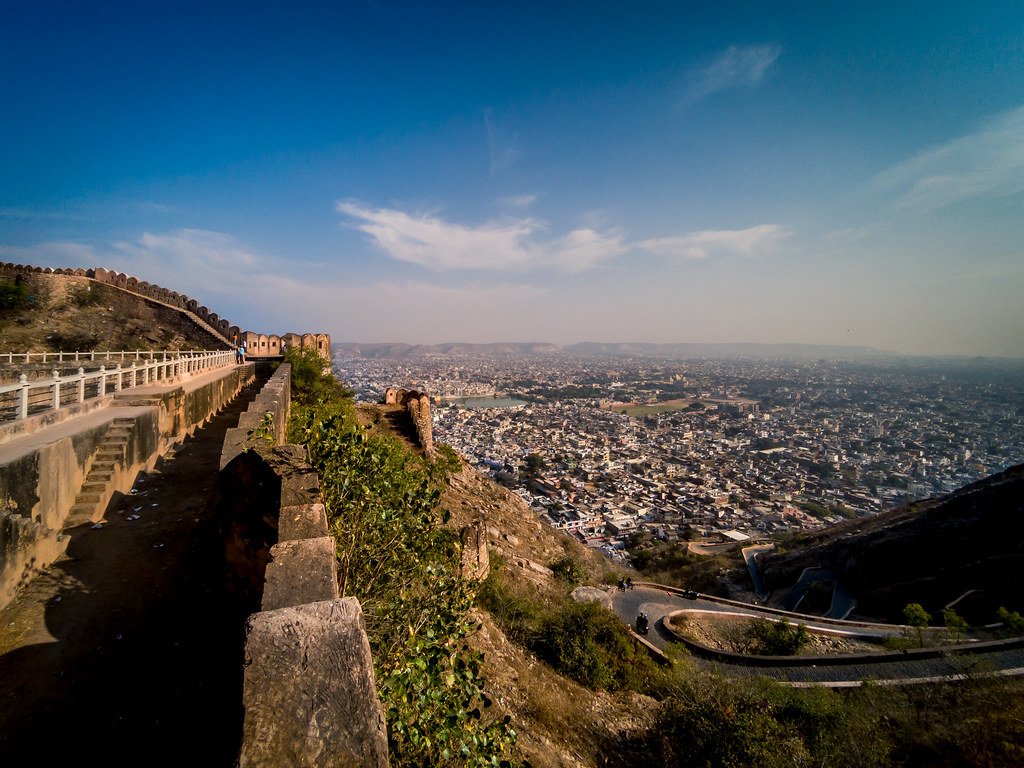
11. Mukesh Art Gallery
Mukesh Art Gallery is a place where you can admire and buy a variety of paintings and handicrafts. The gallery was established in 2000 by Mr. Mukesh Gupta, who is an avid collector and connoisseur of art. The gallery has a curated collection of more than 14,000 paintings in different styles and mediums, which are displayed in an area of about 16,000 sq.ft. The gallery also has a section of marble articles and framed museum quality prints. Mukesh Art Gallery is a destination for art lovers and collectors.
12. Rajasthan Small Scale Cottage Industry
The Rajasthan Small Scale Cottage Industry in Jaipur is a hub for traditional craftsmanship, offering a wide array of handcrafted products showcasing the rich heritage of Rajasthan. Visitors can explore and purchase intricately designed textiles, handicrafts, and other traditional items that reflect the state’s cultural richness and artistic skills. The cottage industry plays a significant role in preserving and promoting the unique crafts of Rajasthan.
13. Albert Hall Museum
The Albert Hall Museum is a splendid architectural gem that serves as the state museum of Rajasthan. Built-in 1876, it was designed by Sir Samuel Swinton Jacob, combining elements of the Indo-Saracenic style and showcasing exquisite architectural details. The museum houses an extensive collection of artifacts, including paintings, sculptures, carpets, and ancient artifacts, providing visitors with a comprehensive glimpse into the cultural and historical heritage of Rajasthan. The beautifully lit building, especially in the evening, adds to the enchantment of the museum’s visit .The Albert Hall Museum is open from 9:00 AM to 5:00 PM and 7:00 PM to 10:00 PM every day. Admission for Indian visitors is Rs. 40, while foreign tourists pay Rs. 300. Camera usage is charged at Rs. 50, and video camera charges are Rs. 200.
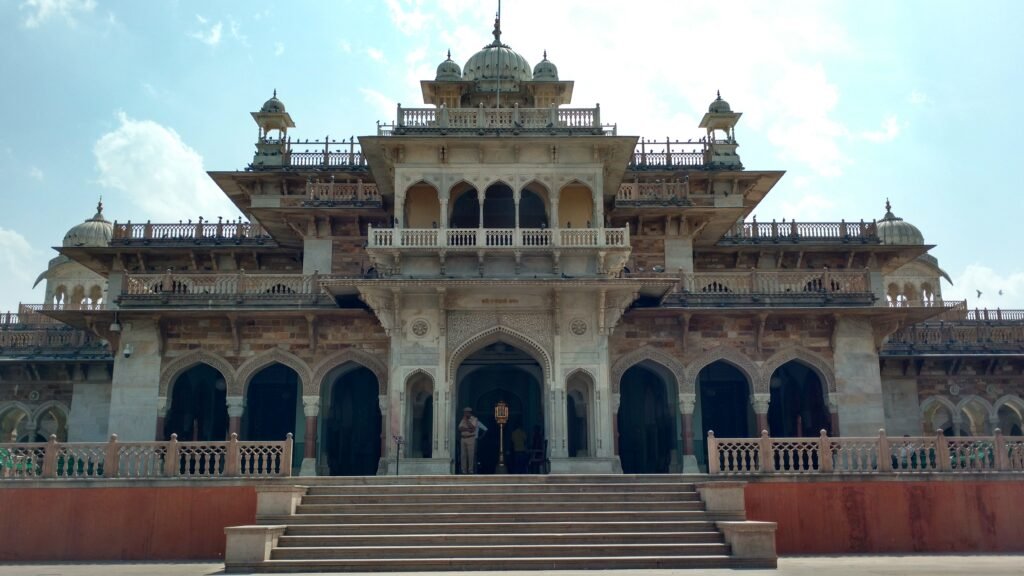
14. Govind Devji Temple
Govind Devji Temple is a historic temple of Gaudiya Vaishnavism tradition. The temple is dedicated to Govind Devji, who is one of the forms of Lord Krishna. The idol of Govind Devji was brought from Vrindavan by Maharaja Sawai Jai Singh II, the founder of Jaipur, who was a devout devotee of the Lord. The temple is considered to be one of the most sacred and significant temples for the followers of Krishna. The temple has seven aartis and bhogs every day, when the devotees can have a darshan of the Lord. The temple also celebrates various festivals such as Janmashtami, Radhashtami, Holi, and Gopashtami with great fervor and devotion.
15. Jal Mahal
Jal Mahal, or the Water Palace, is a beautiful palace that appears to float on the Man Sagar Lake in Jaipur. It was built in the 18th century by Maharaja Jai Singh II of Amber, who renovated and enlarged the original palace and the lake around it. The palace combines the Mughal and Rajput styles of architecture, and has five stories, of which four are submerged under water. The palace is not open to the public, but can be admired from the shore or from a boat. Jal Mahal is a stunning sight, especially at night, when it is illuminated by lights. Jal Mahal is open from 6:00 AM to 9:30 PM every day. The entry free, and the ticket prices are Rs. 10 for Indians and Rs. 50 for foreigners.
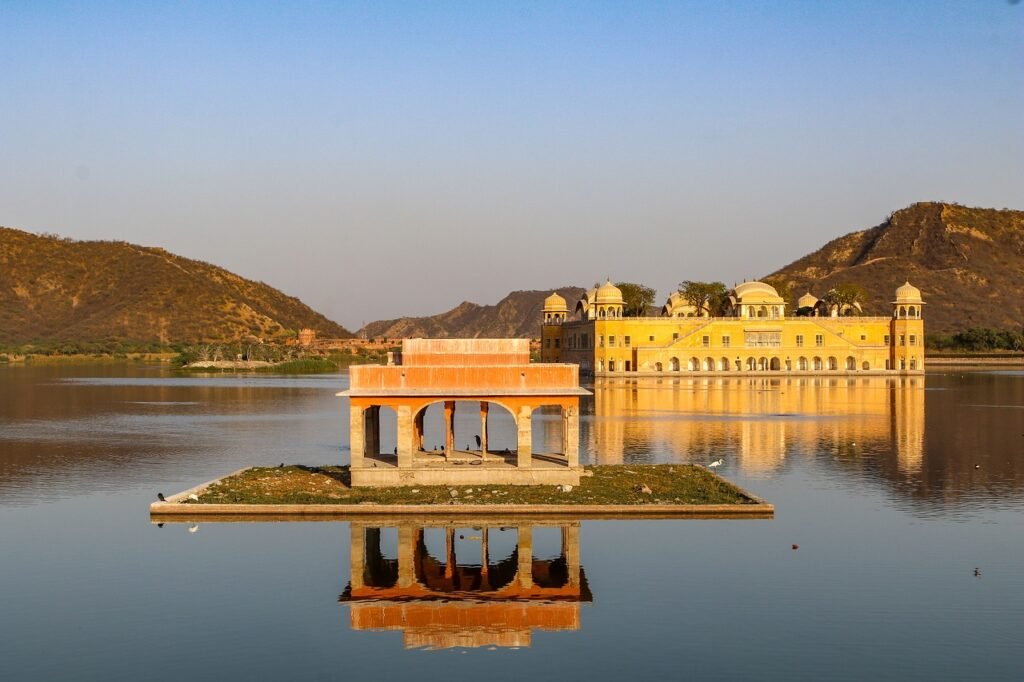
16. Monkey Temple
Monkey Temple, also known as Galta Ji, is a Hindu temple complex located about 10 km east of Jaipur. The temple is dedicated to Galav, a saint who meditated here and was blessed with abundant water by the gods. The temple has seven sacred water tanks, or kunds, where pilgrims bathe and worship. The temple is also home to a large colony of monkeys, which gives it its popular name. Monkey Temple is a place of spiritual and natural beauty, where visitors can witness the devotion of the locals and the playful antics of the monkeys.
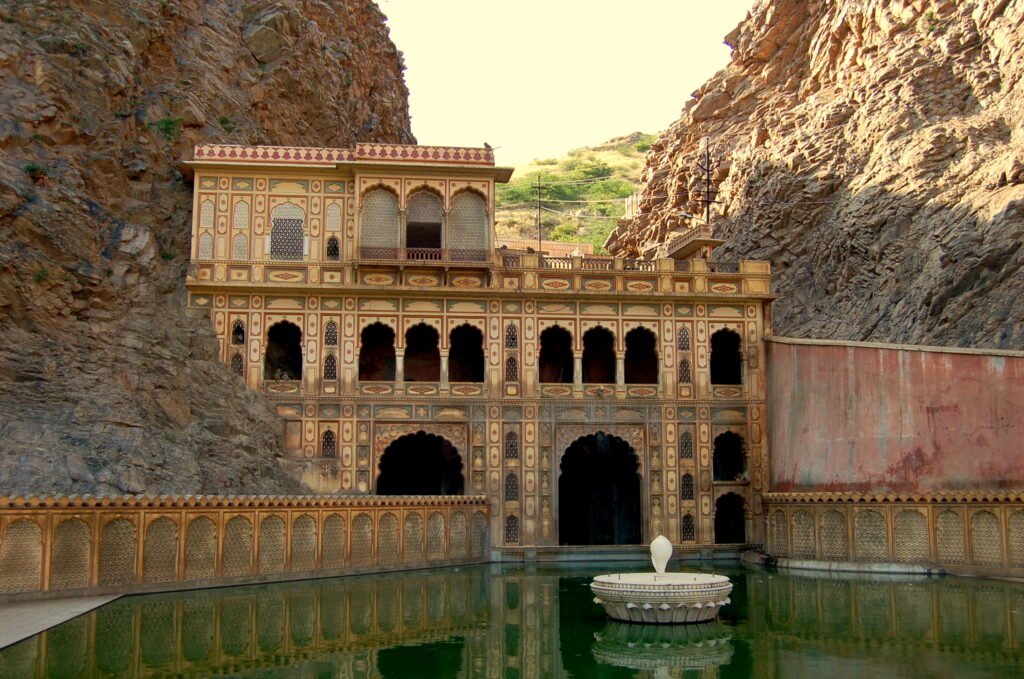
17. Anokhi Museum of Hand Printing
Anokhi Museum of Hand Printing is a museum that showcases the art and craft of hand block printing, a traditional technique of Rajasthan. The museum is located in a restored haveli, or mansion, near the Amer Fort in Jaipur. The museum displays a collection of block printed textiles, garments, tools, and blocks, some of which date back to the 1960s. The museum also organizes demonstrations, workshops, and exhibitions to promote and preserve this heritage skill. Here’s the information presented in a table format:
| Day | Timings |
|---|---|
| Tuesday to Saturday | 10:30 AM to 5:00 PM |
| Sunday | 11:00 AM to 4:30 PM |
| Monday | Closed |
| Summer Closure | May 15th to July 15th (for maintenance) |
| Admission Fees | Amount (in INR) |
|---|---|
| Adults | 30 |
| Students | 20 |
| Children | 15 |
| Still Camera | 50 |
| Video Camera | 150 |
Anokhi Museum of Hand Printing is a captivating destination for art and culture lovers.
18. Dera Amer Wilderness Camp
Dera Amer Wilderness Camp is a place where you can enjoy a luxury glamping experience in the wilderness near Jaipur. You can interact with rescued elephants, a camel, dogs, and other animals in a compassionate and ethical way. You can also admire the natural beauty and historical sites of the area, such as the Amer Fort. The camp has limited tents with modern amenities and offers delicious meals and activities. Dera Amer Wilderness Camp is a destination for animal lovers and adventure seekers. The price of the luxury tents starts from Rs. 9,000 per night.
19. Moti Dungari Temple
Moti Dungri Temple is a Hindu temple complex dedicated to Lord Ganesha. It was built in 1761 by Seth Jai Ram Paliwal, who brought the idol of Ganesha from Udaipur. The temple is located at the bottom of a hill that resembles a pearl, hence the name Moti Dungri. The temple is a popular tourist attraction and a place of worship for devotees of Ganesha. The temple celebrates various festivals such as Ganesh Chaturthi, Krishna Janmashtami, and Annakut with great fervor and devotion.
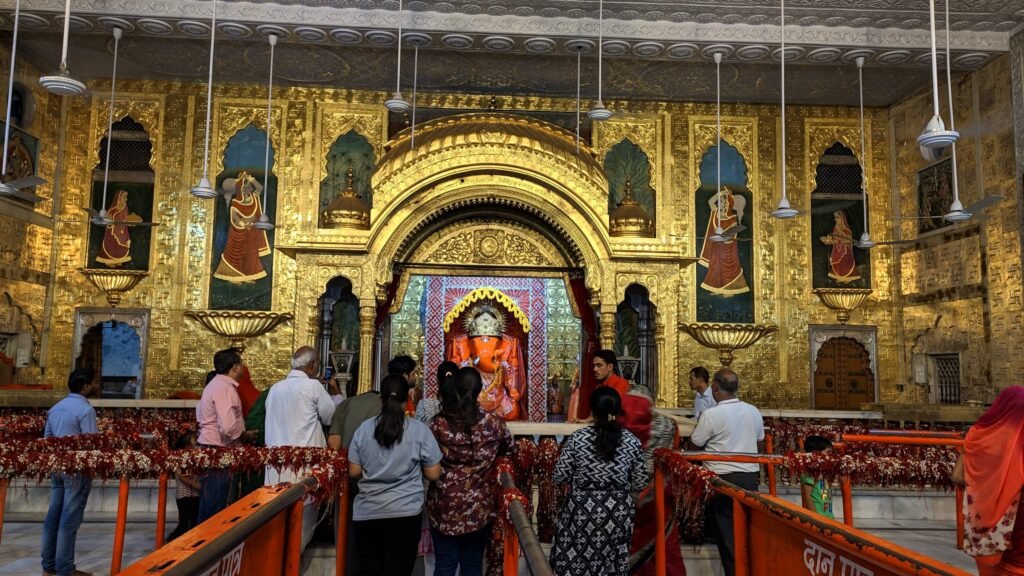
20. Panna Meena ka Kund
Panna Meena ka Kund is a 16th-century stepwell located in Amer, a sub-city of Jaipur. It is one of the many stepwells that were built in Rajasthan to store water for drinking, irrigation, and religious purposes. Stepwells are unique architectural marvels that combine functionality and aesthetics. Panna Meena ka Kund is a square-shaped stepwell, with adjoining stairs on all four sides and a room on the northern wall. It is believed that this room was used for religious ceremonies before weddings or on popular festival dates. Panna Meena ka Kund is a beautiful and historic attraction, where visitors can witness the ancient water harvesting system and the geometric symmetry of the structure.
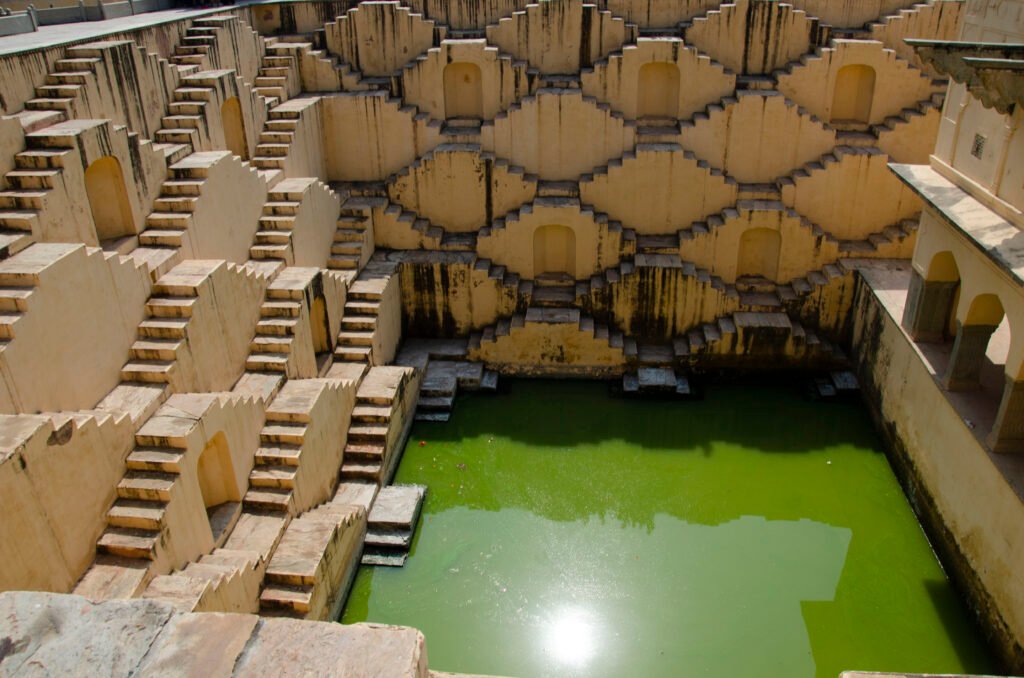
21. World Trade Park
World Trade Park stands as a prominent shopping mall in Jaipur, covering an extensive area of around 1 million square feet. Renowned for its fusion of modern and traditional Rajasthani architecture, the mall boasts a distinctive pink sandstone façade. Housing a diverse range of shops, including both national and international brands, electronics outlets, home decor stores, and a hypermarket, it caters to various shopping needs. The mall also features a food court and multiple restaurants offering Indian and international cuisines. Additionally, it includes a multiplex cinema with multiple screens for a diverse movie experience. World Trade Park is a popular destination for shopping and entertainment, drawing both locals and tourists. The mall operates from 10:30 AM to 11:00 PM every day, with entry priced at Rs. 30 per person, and discounts available for students, senior citizens, and groups.
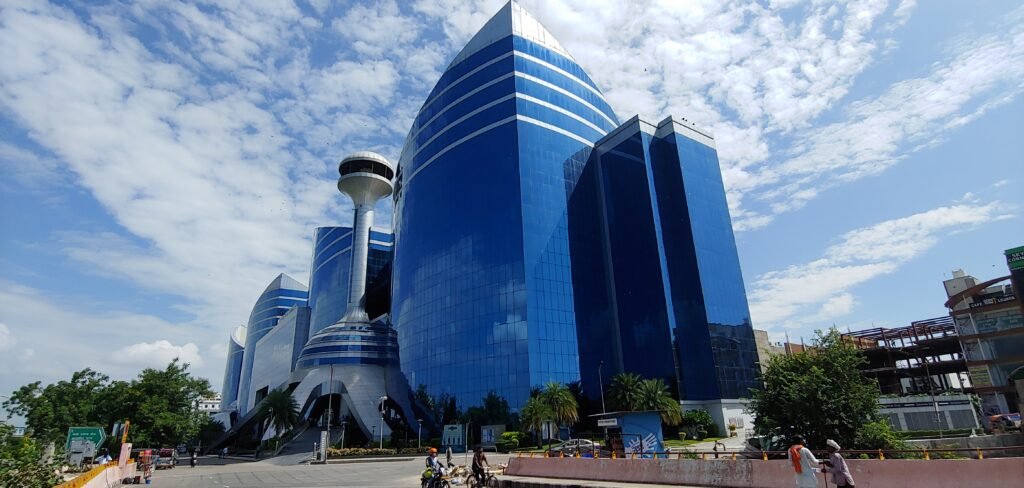
22. Akshardham Temple
Akshardham Temple is a magnificent temple dedicated to Lord Narayan, also known as Lord Vishnu, the preserver of the universe. The temple is located in Vaishali Nagar, Jaipur, and is one of the most popular tourist attractions of the city. The temple showcases the rich cultural heritage and architectural beauty of India, with its stunning idols, sculptures, carvings, and gardens. The temple is also a place of spiritual bliss and peace, where devotees can worship and meditate.
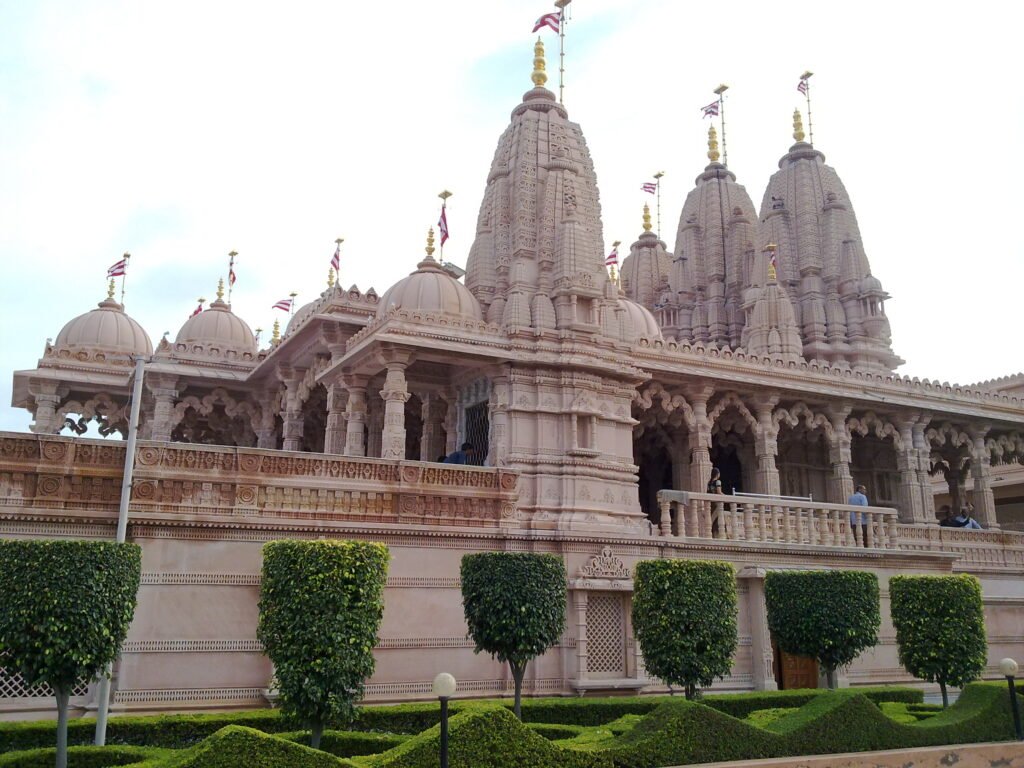
23. Royal Gaitor Tumbas
Royal Gaitor Tumbas, serves as the cremation ground for the Kachwaha Rajput rulers. Adorned with splendid marble cenotaphs (chhatris), it commemorates notable maharajas like Pratap Singh and Jai Singh II. Nestled beneath Nahargarh Fort amidst the tranquil Aravalli hills, this historical site showcases Rajput grandeur through its architectural prowess. A visit to Royal Gaitor Tumbas is a compelling experience for those intrigued by Jaipur’s rich history and culture.
24. Gyan Museum
Gyan Museum is a concept museum, that showcases the personal collection of Late Mr. Gyan Chand Ji Dhaddha, a naturalist, collector, and gemologist. The museum has over 2500 works of art, ranging from textiles, paintings, jewellery, silverware, arms, and accessories, to coins, manuscripts, and decorative arts. The museum reflects the rich and diverse cultural heritage of India and beyond, spanning over 3000 years of history. The museum also has a jewellery store, GYAN Jaipur, that offers contemporary designs inspired by the museum’s collection. Gyan Museum is a place where you can admire the beauty and craftsmanship of rare and exquisite objects, and learn about the stories and legends behind them.
25. Khole Ke Hanuman JI Temple, Jaipur
Khole Ke Hanuman JI Temple is a popular Hindu temple dedicated to Lord Hanuman, the monkey-god, It is located on a hilltop and offers scenic views of the surrounding hills and valleys. The temple was built in 1960 by Pandit Radhe Lal Choubey, who found a rock with a carving of Lord Hanuman on it. The temple is famous for its prasad, a sacred food offering, which consists of dal-bati churma, a traditional Rajasthani dish. The temple attracts thousands of devotees and tourists every year, especially on Tuesdays and Saturdays, which are considered auspicious days for Lord Hanuman.
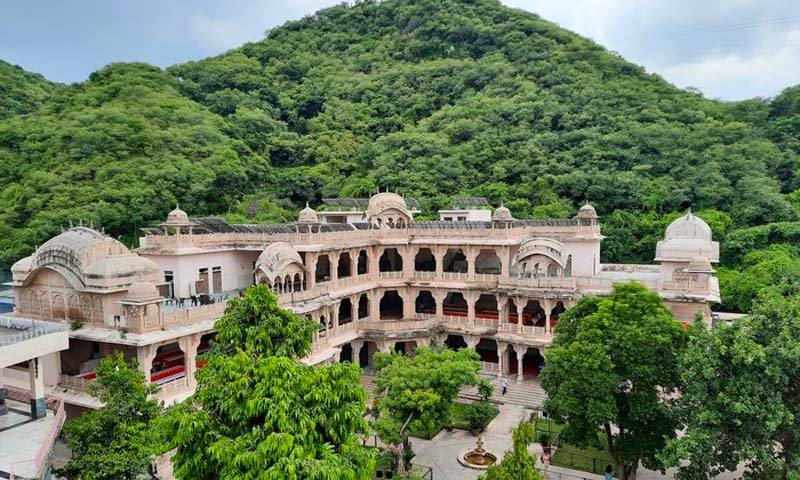
26. Heritage Textiles
Heritage Textiles is a popular outlet in Jaipur, that specializes in handcrafted textiles, pashmina shawls, home furnishings, and bed linen. They offer a variety of fabrics, such as organic cotton, linen, silk, satin, and wool, in different styles, such as printed, embroidered, quilted, and textured. They also provide made to measure dresses and express tailoring services. Heritage Textiles has a loyal clientele of famous designers and fashion boutique owners from around the world. You can visit their website or their showroom to explore their exclusive collection of cashmere and pashmina shawls. Heritage Textiles is a destination for anyone who loves quality, elegance, and craftsmanship.
27. Patrika Gate
Patrika Gate is a stunning monument and tourist attraction in Jaipur. It was built in 2016 by the Patrika group of Newspapers as an entrance to Jawahar Circle Garden, which is the biggest circular park in Asia. , with a diameter of 452 meters and a circumference of 1,420 meters. The gate showcases the architectural and cultural heritage of Rajasthan, with colourful paintings and murals depicting the different regions and aspects of the state. Patrika Gate is a popular spot for photography, as its vibrant colours and arches create a beautiful contrast with the sky. You can visit Patrika Gate at any time of the day, but the best time is early in the morning or evening, when the crowds are less and the light is softer. You can also enjoy the musical fountain show at Jawahar Circle Garden every evening from 7 pm to 7:30 pm. Patrika Gate is a must-see attraction for anyone who loves art, history, and culture.
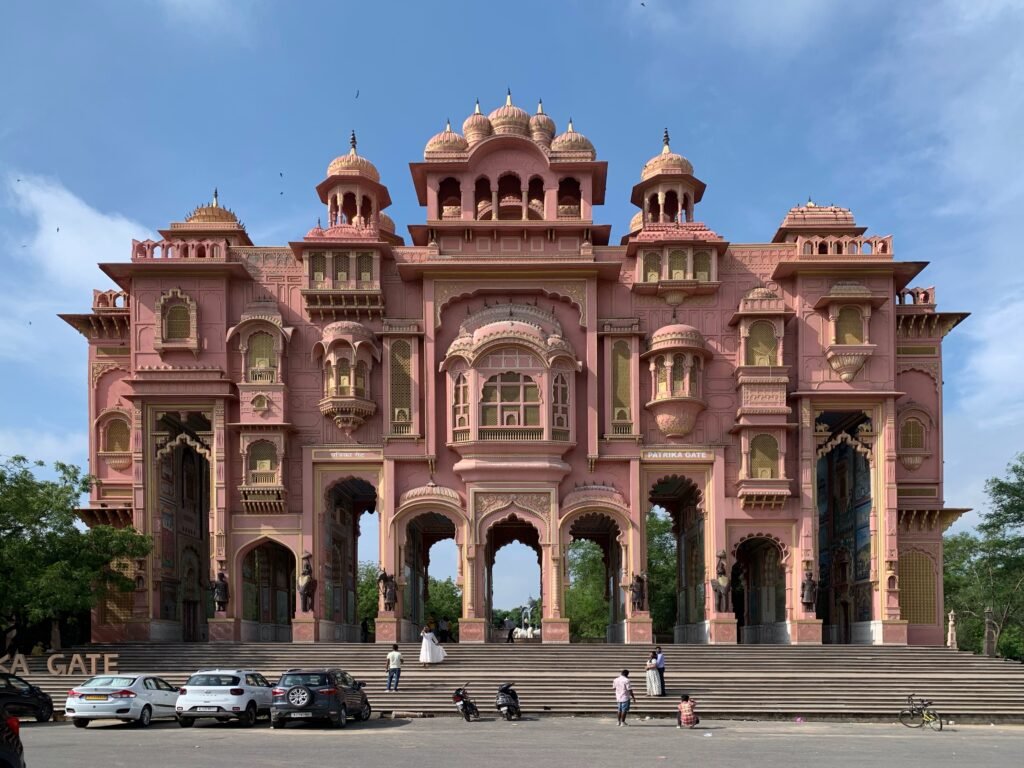
28. Chokhi Dhani Jaipur
Chokhi Dhani Jaipur is a resort and village that showcases the culture, cuisine, and heritage of Rajasthan. It is located on the outskirts of Jaipur, about 20 kilometres from the city centre. Visitors can enjoy various activities and attractions, such as folk performances, puppet shows, animal and cart rides, temples, and a replica of the Haldighati battle. They can also savour authentic Rajasthani dishes, such as dal bati churma and ghee-based sweets, at the resort’s restaurants. Chokhi Dhani Jaipur is a perfect place to experience the rural and royal aspects of Rajasthan in a single destination. Chokhi Dhani Jaipur, open from 5:00 pm to 11:00 pm daily, charges Rs. 700 for adults and Rs. 400 for children. The cost for two people is approximately Rs. 1200.
29. Masala Chowk
Masala Chowk is an open-air food court in Jaipur. It offers a variety of delicious and authentic Indian street food from 21 different stalls. You can enjoy dishes such as chole bhature, aloo tikki, pani puri, jalebi, pyaz ki kachori, samosa, dosa, idli, and more. Masala Chowk is located inside Ram Niwas Garden, which is also a tourist attraction with a zoo, a museum, and a musical fountain. Masala Chowk is a great place to experience the flavours and culture of Jaipur. Operating Hours: Masala Chowk welcomes visitors daily from 10 am to 10:30 pm. The admission fee is Rs. 10 per person, with an estimated cost of around Rs. 400 for two individuals.
30. Gatore ki Chhatriyan
Gatore ki Chhatriyan is a royal crematorium complex in Jaipur, where the Kachwaha Rajput rulers were cremated. The complex was established by Maharaja Jai Singh II, the founder of Jaipur, in the 18th century. It contains many beautiful and ornate cenotaphs, or chhatris, that mark the cremation spots of the former kings. The cenotaphs are made of marble or sandstone, and have intricate carvings of elephants, battles, and nature. Gatore ki Chhatriyan is a hidden gem that showcases the rich history and culture of the Kachwaha dynasty.
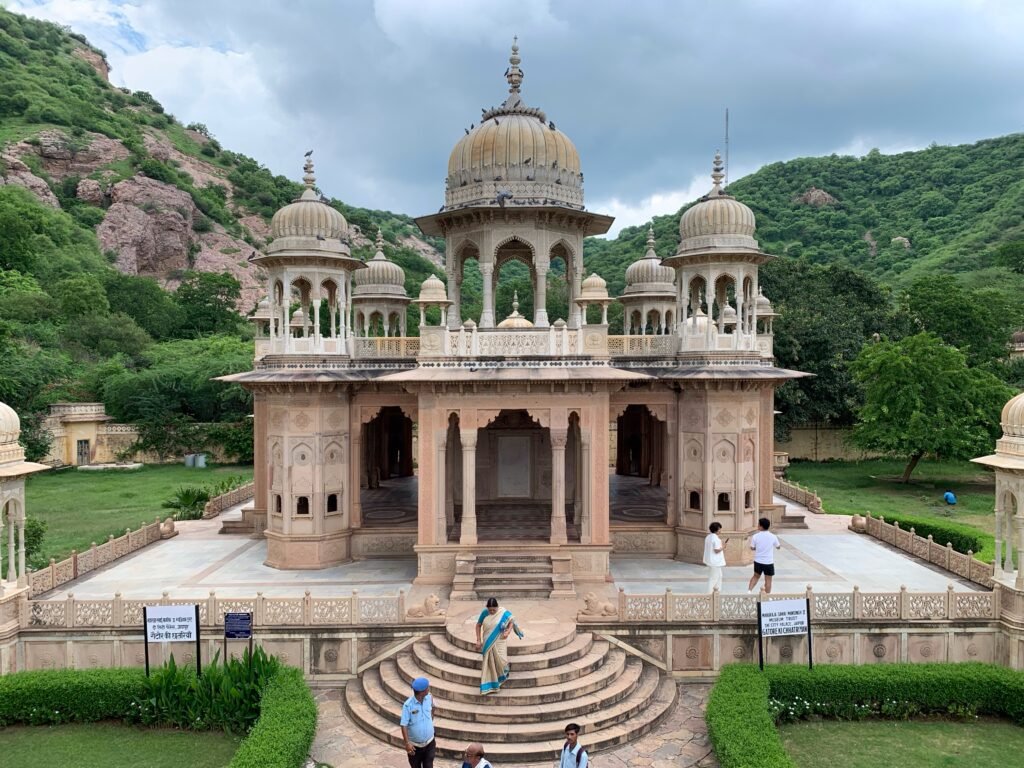
31. Amrapali Museum
Amrapali Museum is a museum in Jaipur that showcases the rich tradition and craftsmanship of Indian jewellery and decorative objects. It was founded by Rajiv Arora and Rajesh Ajmera, the owners of Amrapali Jewels, who collected rare and exquisite pieces of jewellery over four decades. The museum displays over 800 objects, ranging from tribal jewellery, silver and gold ornaments, religious objects, personal accessories, textiles, and more. The museum is a hidden treasure that reveals the history and culture of Indian jewellery making. The Amrapali Museum welcomes visitors every day from 11 am to 6 pm, excluding Sundays. Admission is priced at Rs 600 per person and includes a complimentary audio tour guide.
32. Amar Jawan Jyoti
Amar Jawan Jyoti in Jaipur is a memorial commemorating soldiers and martyrs who served during wartime, erected after the Indo-Pakistani War of 1971. Inaugurated by Prime Minister Indira Gandhi in 1972, the memorial features a black marble pedestal with a reversed rifle and war helmet, encircled by perpetual flames. Often referred to as the “flame of the immortal soldiers,” it bears resemblance to the India Gate in Delhi.
33. Jaipur Zoo
Jaipur Zoo is a popular destination for wildlife enthusiasts and families. Sprawling across a vast area, the zoo is home to a diverse collection of animals, including lions, tigers, elephants, and various bird species. Visitors can enjoy a stroll through well-maintained enclosures, gaining insights into the rich biodiversity. The zoo also contributes to conservation efforts and educates the public about the importance of wildlife preservation. With its engaging exhibits, Jaipur Zoo provides an enjoyable and educational experience for visitors of all ages. The Jaipur Zoo welcomes visitors every day from 11 am to 6 pm, excluding Sundays. Admission is Rs 600 per person, and it includes a complimentary audio tour guide.
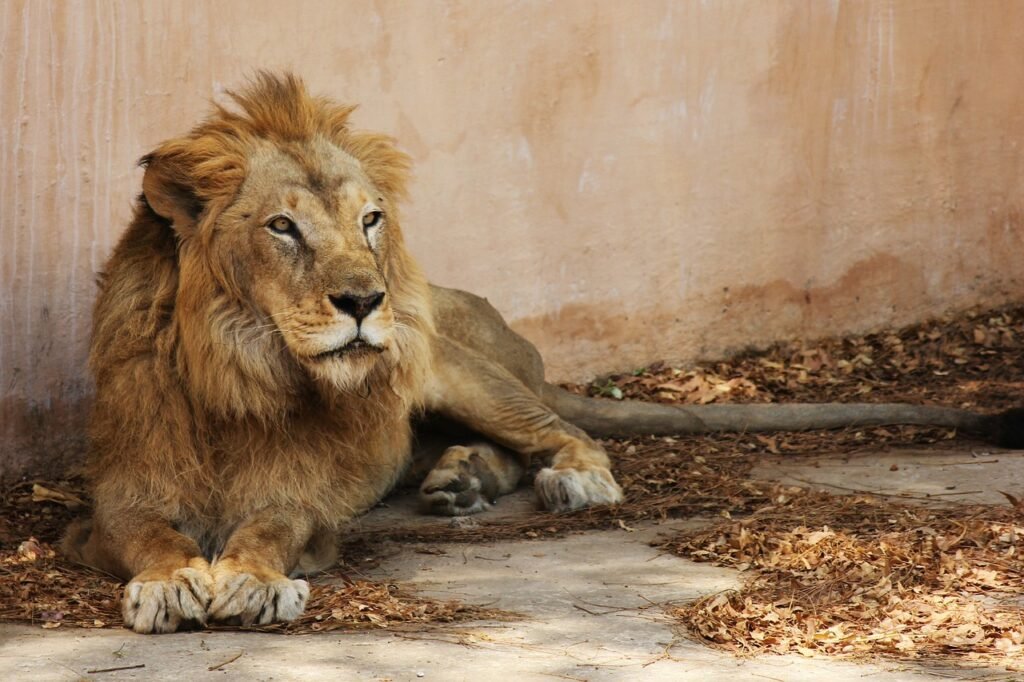
34. Central Park Jaipur
Central Park in Jaipur is a sprawling urban park that offers a serene retreat in the heart of the city. Boasting lush greenery, a sparkling lake, and well-maintained pathways, it provides an ideal space for leisurely strolls, jogging, and relaxation. The park features iconic attractions like the Patrika Gate and a giant chessboard. With its tranquil ambiance, It also has a 206 feet high National flag, Central Park serves as a popular destination for locals and tourists seeking a peaceful escape amidst nature. The Central Park Jaipur is open on all days of the week from 5:00 am to 9:00 pm. There is no entry fee to enter the park.
35. Sisodia Rani Garden
Sisodia Rani Garden is a picturesque garden with historical significance. Built in 1728 by Maharaja Sawai Jai Singh II for his queen, Sisodia, it reflects the Mughal-style landscape architecture. Adorned with terraced levels, pavilions, fountains, and vibrant murals depicting the love story of Radha-Krishna, the garden offers a charming blend of natural beauty and cultural richness. Sisodia Rani Garden serves as a tranquil haven, inviting visitors to appreciate its ornate design and immerse themselves in the historical allure of Jaipur. The garden welcomes visitors from 8:00 am to 5:00 pm daily. The entry fee is INR 50 for Indian nationals and INR 200 for foreign nationals. Additionally, a captivating fountain show is available after 7:00 pm for added enjoyment.
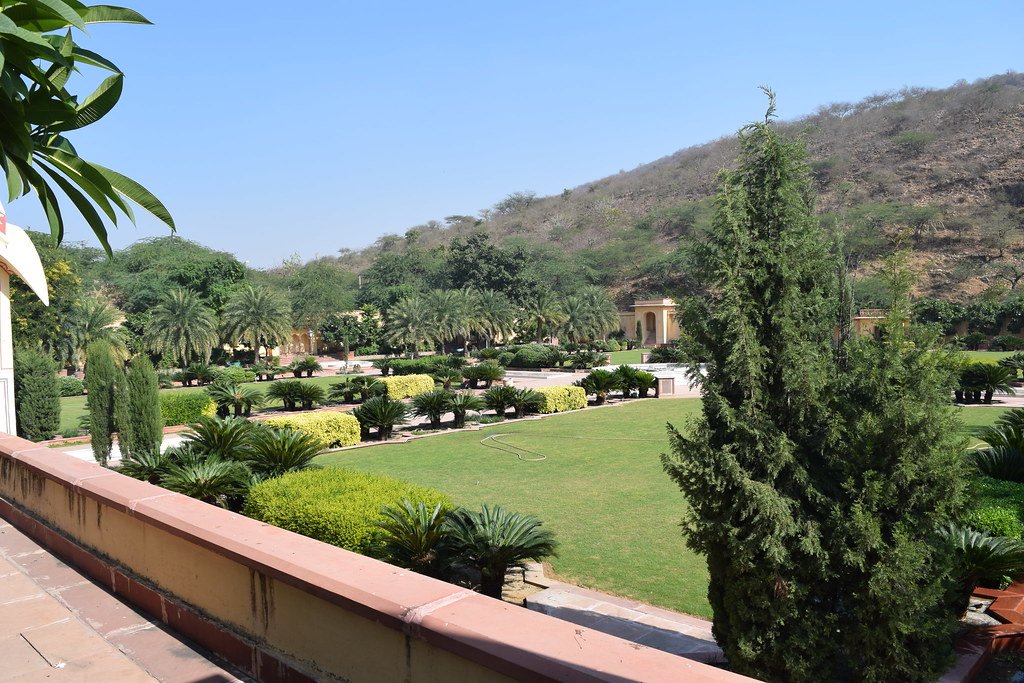
36. Rambagh Palace
Rambagh Palace is a majestic palace hotel in Jaipur, the former residence of the Maharaja of Jaipur and his royal family. The palace was built in 1835 and showcases a blend of Rajput and Mughal architecture, with lavish interiors, exquisite gardens, and elegant fountains. The palace offers a glimpse of the royal lifestyle and heritage of Jaipur, with luxurious rooms and suites, fine dining, and world-class amenities. Rambagh Palace is a perfect destination for travelers who want to experience the splendor and romance of the bygone era of the Rajputs. Rambagh Palace in Jaipur is open daily from 9:00 am to 5:00 pm. Visitors, with an entry fee of INR 700 for Indian nationals and INR 1500 for foreign nationals, can explore public areas such as gardens and main halls.
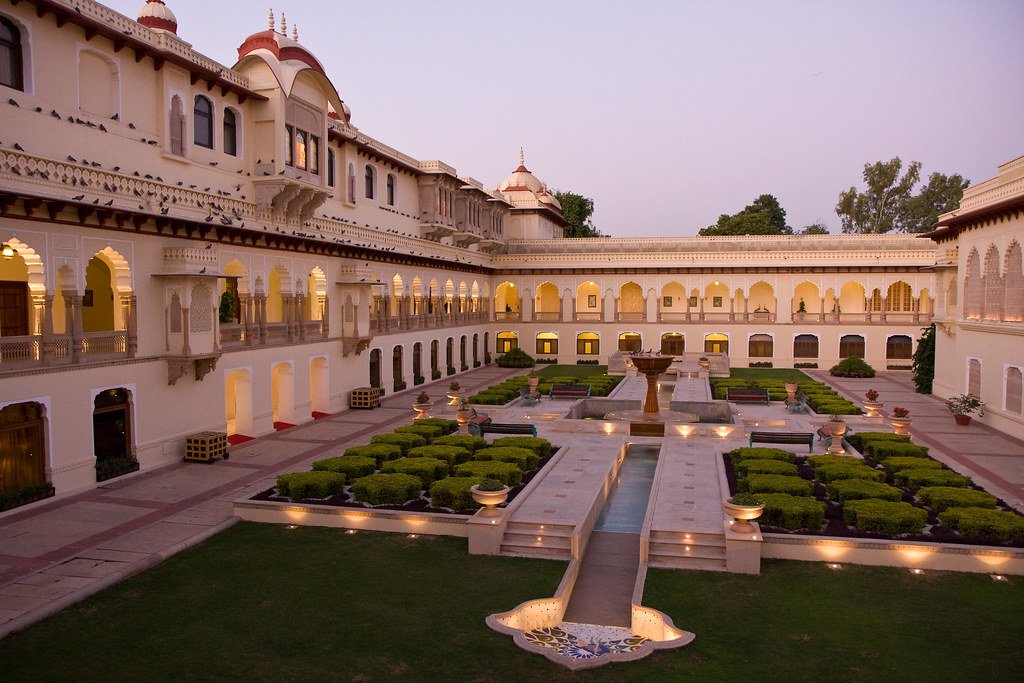
37. Ram Niwas Garden
Ram Niwas Garden in Jaipur is a historical garden that offers a serene retreat. Opened in 1868 by Maharaja Sawai Ram Singh II, it features lush greenery, a zoo, an aviary, and the iconic Albert Hall Museum. The garden is a popular destination for locals and tourists seeking leisure and cultural experiences. Visitors can enjoy the peaceful ambiance, explore the museum, and appreciate the diverse flora within the well-maintained premises. The garden serves as a recreational space and a cultural hub, contributing to the vibrant heritage of Jaipur. The garden is open from Wednesdays to Mondays, from 9:00 am to 5:00 pm during winters and from 8:30 am to 5:30 pm during summers. The garden is closed on Tuesdays. The entry fee is INR 10 for Indian nationals and INR 100 for foreign nationals.
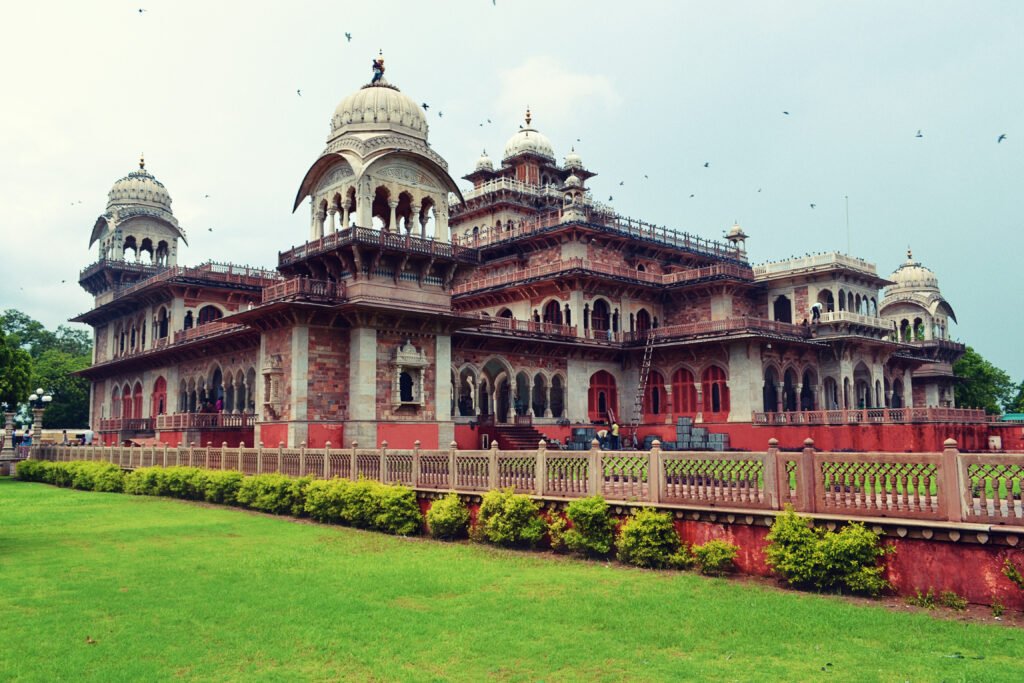
38. Digamber Jain Mandir Sanghiji
Digamber Jain Mandir Sanghiji is a Jain temple located in Sanganer town, 16 km away from Jaipur. It is dedicated to Lord Adinath, the first Jain Tirthankara. The temple is made of red sandstone and has a Shikhara style architecture. The temple has seven underground floors that are closed for visitors. The temple has many carvings of lotuses, creepers, and elephants on the inner walls. The temple is a popular pilgrimage site for Jains and a historical attraction for tourists.
39. Kanak Vrindavan Garden
Kanak Vrindavan Garden, nestled at the base of Nahargarh hills near Amer Fort, was commissioned by Maharaja Sawai Jai Singh II in 1728 for his second queen. This regal garden, blending Mughal and Rajput architecture, features floral beds, fountains, and murals depicting Radha Krishna. The garden houses the intricately adorned Shri Govind Deoji Parisar temple dedicated to Lord Krishna. Renowned for its scenic allure, historical importance, and cultural events, Kanak Vrindavan Garden is a cherished destination for tourists. The garden welcomes visitors from 8:00 am to 5:00 pm every day. The entry fee is INR 10 for Indian nationals and INR 20 for foreign nationals.
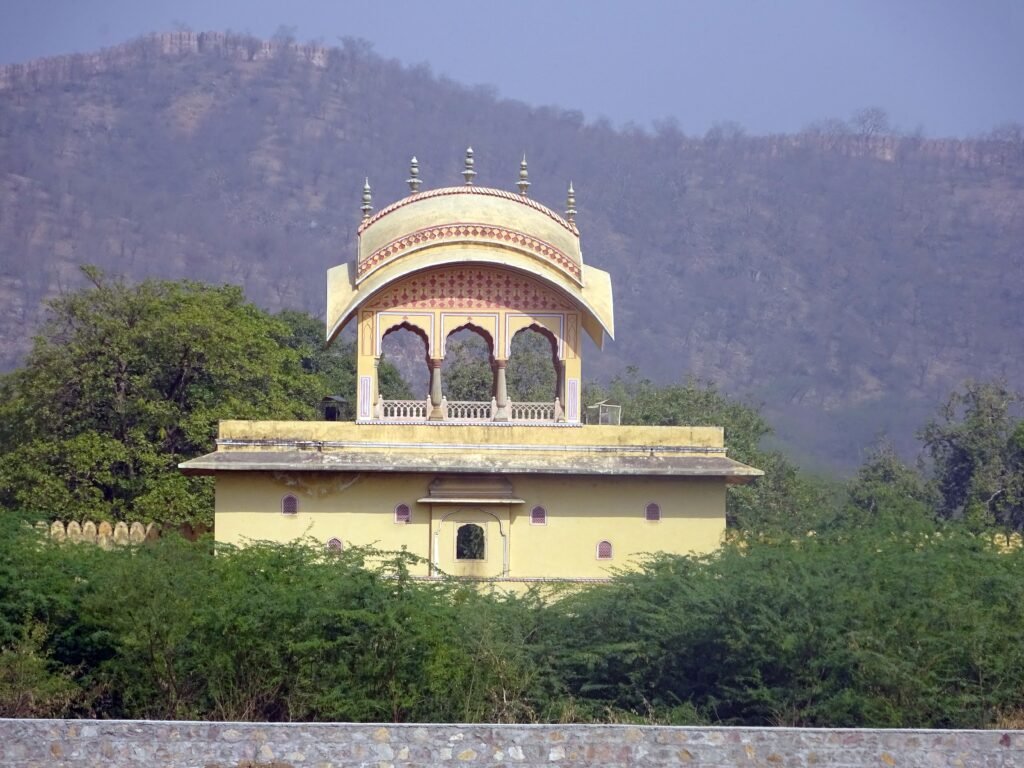
40. Sargasuli Tower
Sargasuli Tower, also known as Isar Lat, is a historical monument in Jaipur. It was built by Maharaja Sawai Ishwari Singh in 1749 to commemorate his victory over his half-brother, Sawai Madho Singh, in the battle of Rajmahal. The tower is a seven-tiered minaret, inspired by the Qutub Minar of Delhi and the Kirti Stambh of Chittorgarh. The tower has a spiral staircase and a balcony on each floor, offering a panoramic view of the city. The tower is located near the Tripolia Gate of the City Palace, in the Aatish market area. It is a popular tourist attraction for its architecture, history, and culture. The tower is open from 9:30 am to 4:00 pm on all days of the week. The entry fee is INR 70 for Indian nationals and INR 1500 for foreign nationals.
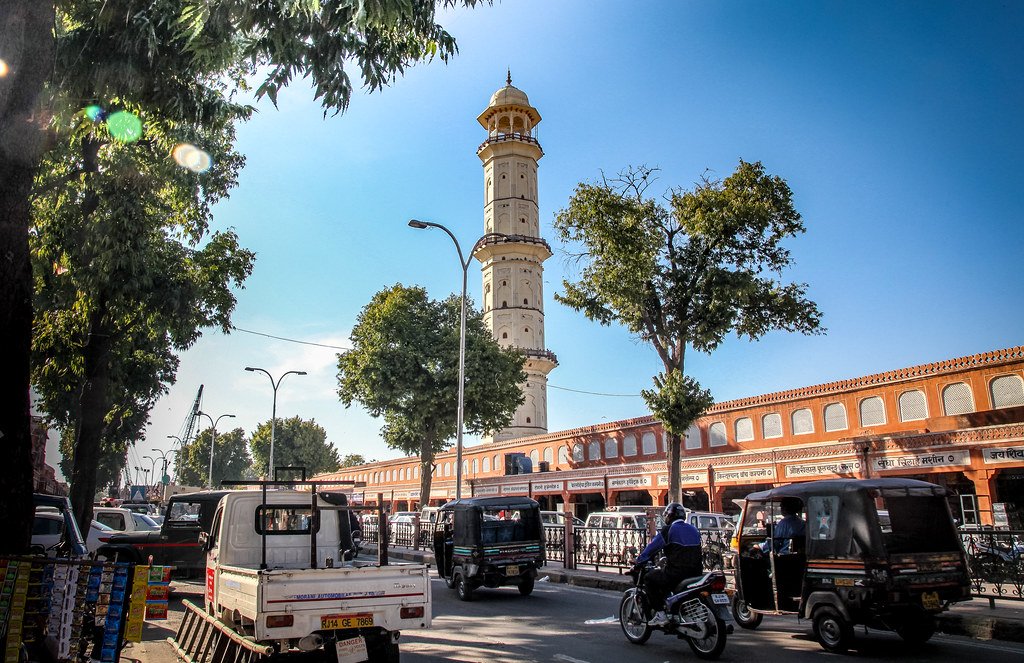
41. Garh Ganesh Temple
Garh Ganesh Temple is an ancient temple of Lord Ganesh in Jaipur. It was built by Maharaja Sawai Jai Singh before he laid the foundation stone of the city in 1727. The temple is located on the hills near Nahargarh Fort and Jaigarh Fort, offering a panoramic view of the city. The temple is unique because it worships Lord Ganesh in his child form, without a trunk, known as Vigra Purushakriti. The temple is a popular pilgrimage site for devotees of Lord Ganesh, especially during the festivals of Ganesh Chaturthi and Paush Bada.
42. Hari Mahal Palace
Hari Mahal Palace is a heritage hotel in Jaipur, the former residence of Rajadhiraj Hari Singh of Achrol, a royal family of Jaipur. The palace was built in the 1930s and has a blend of modern and traditional decor, with spacious rooms, a restaurant, a bar, and an indoor pool. The palace is located in the heart of the city, near the Tripolia Gate of the City Palace. The palace offers a glimpse of the royal lifestyle and heritage of Jaipur, with original artworks and photographs from the Achrol and Pachar family. Hari Mahal Palace is a perfect destination for travelers who want to experience the charm and elegance of the bygone era of the Rajputs. Rambagh Palace in Jaipur welcomes visitors from 9:00 am to 5:00 pm daily, functioning primarily as a luxury hotel. While not all areas are accessible, visitors can explore designated public spaces, including gardens and select halls, by paying an entry fee of INR 700 for Indian nationals and INR 1500 for foreign nationals.
43. Jaipur Exhibition & Convention Centre (JECC)
Jaipur Exhibition & Convention Centre (JECC) is a state-of-the-art facility for hosting various events such as exhibitions, conferences, seminars, banquets, and entertainment shows. Located in the industrial area of Sitapura, JECC is the largest pillar-less convention centre in South Asia, with a total area of 42 acres. JECC has two spacious exhibition halls, a grand ballroom, 14 meeting venues, a lawn, and an outdoor exhibition area. JECC also provides end-to-end event management services, catering, security, parking, and audio-visual equipment. JECC is a unit of Diligent Pinkcity Center Pvt. Ltd. and is expected to have a five-star hotel on its premises soon. JECC is the ideal destination for organizing world-class events in the Pink City of Jaipur.
These were the best places to visit in Jaipur for couples & families hope you liked it. Have a safe journey !
Best Time To Visit Jaipur:
The best time to visit Jaipur is from October to March, offering pleasant weather, cultural festivals, and a chance to explore iconic landmarks. However, this period is also the peak tourist season. To avoid extreme heat and monsoon disruptions, it’s recommended to avoid visiting from April to September. Jaipur provides a rich cultural experience and showcases the heritage of Rajasthan.
How To Reach Jaipur From Delhi:
By Train:
Jaipur is well-connected to Delhi by train. Trains like Shatabdi Express and Rajdhani Express provide comfortable and quick transportation. The journey takes around 4-6 hours, depending on the type of train.
Here is a table of train options from Delhi to Jaipur:
| Train Name | Train Number | Departure Station | Arrival Station | Travel Time | Fare (3A) |
|---|---|---|---|---|---|
| Vande Bharat Express | 20978 | Delhi Cantt (DEC) | Jaipur (JP) | 3h 25m | ₹1,100 |
| Swarna Jayanti Rajdhani Express | 12958 | New Delhi (NDLS) | Jaipur (JP) | 3h 50m | ₹1,200 |
| Rajasthan Sampark Kranti Express | 22463 | Delhi Sarai Rohilla (DEE) | Jaipur (JP) | 4h 5m | ₹700 |
| Delhi Sarai Rohilla – Jaipur AC Double Decker Express | 12986 | Delhi Sarai Rohilla (DEE) | Jaipur (JP) | 4h 25m | ₹600 |
| Shatabdi Express | 12015 | New Delhi (NDLS) | Jaipur (JP) | 4h 30m | ₹1,000 |
These trains offer a range of travel times and fare options. You can check availability, confirmation probability, and punctuality reports on various websites such as RailYatri, eTrain, redBus, or Goibibo.
By Bus:
- Rajasthan State Road Transport Corporation (RSRTC) operates buses between Delhi and Jaipur. The bus journey takes approximately 5-7 hours, depending on the type of bus and traffic conditions.
By Car:
- You can also hire a taxi or drive from Delhi to Jaipur. The journey takes approximately 5-6 hours, depending on the route and traffic.
Nearest Places To Jaipur:
| City | Distance from Jaipur | Attractions |
|---|---|---|
| Pushkar | 161 km | Brahma Temple, Pushkar Lake, Camel Fair |
| Ranthambore | 122 km | Ranthambore National Park, Ranthambore Fort, Trinetra Ganesh Temple |
| Alwar | 138 km | Bala Quila, City Palace, Siliserh Lake |
| Ajmer | 153 km | Ajmer Sharif Dargah, Ana Sagar Lake, Adhai Din Ka Jhonpra |
| Bharatpur | 184 km | Keoladeo National Park, Lohagarh Fort, Bharatpur Palace |
Trending Articles:
Panna National Park | Panna Tiger Reserve & Wildlife Safari | Ultimate Tour Guide
Pench National Park | Ultimate Tour Guide | Tiger Reserve & Wildlife Safari
35 Best Places To Visit In Jaisalmer | Top Things To Do | Jaisalmer Tourism



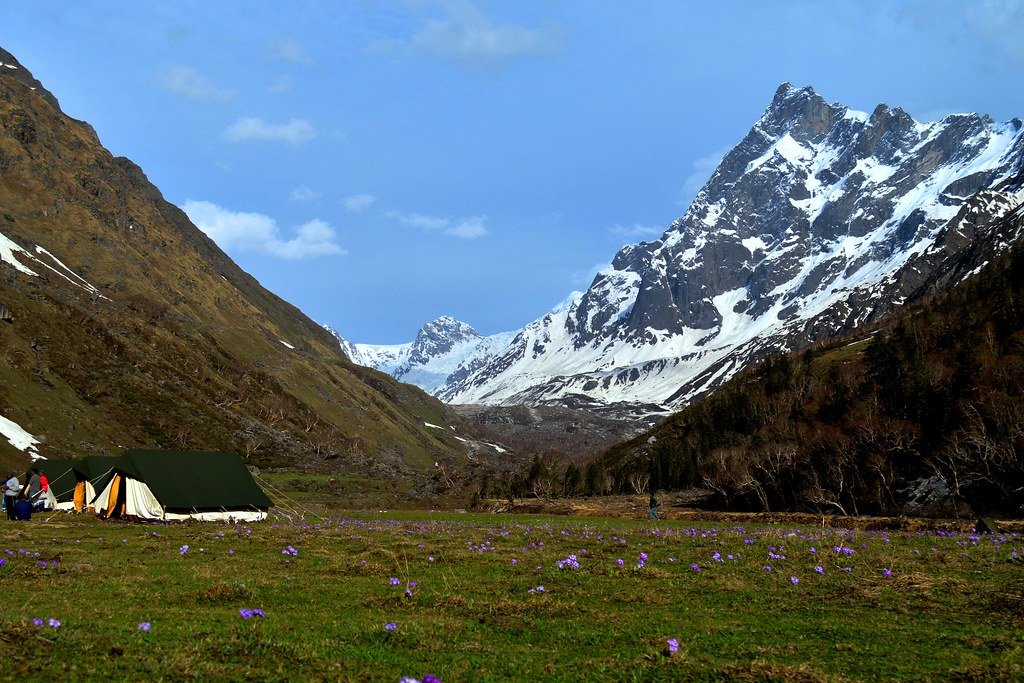
Pingback: Top 10 Places To Visit In Ghaziabad | Things To Do